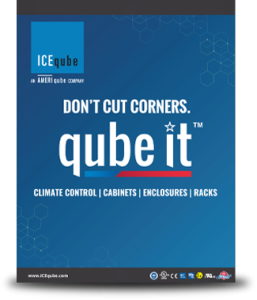Evaporator Coil Freeze-Up on Enclosure Cooling Systems
The evaporator coil is the part of the cooling system where unwanted heat from the inside of the enclosure is transferred to the cold refrigerant flowing inside of the evaporator coil. It is basically a heat exchanger constructed of heat conductive materials, such as copper and aluminum, in a fin and tube configuration. Heated air from the enclosure is typically moved to and across the evaporator coil surface by a fan or blower to make the heat transfer possible. This helps to maintain a safe operating environment for the equipment inside of the enclosure.
When the cooling system is in normal operation, the refrigerant flowing through the evaporator coil is at a temperature that is below the enclosure air temperature so that heat transfer can occur to cool this air. The coil temperature must also be above the freezing temperature of water so that moisture in the air that condenses onto the coil surface will not freeze. If a condition occurs that would cause the evaporator coil to drop to temperature below the freezing temperature, frozen moisture commonly known as frost, will form on the evaporator surface and act as thermal insulation, slowing the heat transfer from the warm air to the cooler refrigerant inside of the evaporator. This is a condition commonly called coil freeze-up. This slow-down of heat transfer will cause the temperature inside of the enclosure to rise to a temperature that may not be safe for the equipment operating inside of the enclosure. This could lead to equipment failure, damage and downtime that is detrimental to key processes. System operating efficiency is also affected, leading to increased energy and operating costs.
There are numerous field conditions that can lead to evaporator freeze-up.
Insufficient air flow - Systems are designed by manufacturers to have sufficient air flow across evaporator coil to prevent coil freeze-up when the cooling system is properly mounted to an electronic equipment enclosure. Cooling system manufacturers provide recommended openings in the enclosure for the cold air supply and warm air return so as not to impede this air flow. It is important to follow manufacturer instructions for installing the cooling system onto the enclosure. It is also important to not locate enclosure equipment directly in front of and against these air openings that will impede air flow.
Too low of a temperature setpoint – Typically the air conditioner is supplied with a temperature controller. The controller allows the end user to select the temperature at which the cooling cycle will be active. If this temperature setting is below the enclosure equipment design temperature range, the enclosure may become too cold. This can lead to an evaporator coil that is at or below the freezing temperature of any condensation that may have collected on the coil surface causing the condensate to freeze. Too low of a setting will also increase energy consumption and costs. Check with the manufacturer of the enclosure equipment for the safe operating temperature range. This information is generally included in equipment specifications or the user manual.
Low ambient temperature - Operation of the cooling system at lower ambient temperatures may cause freeze-up. The temperature that freeze-up can occur will depend upon the controller cooling temperature set point, enclosure heat load and enclosure air flow of the application.
Damage to the cooling system – If the refrigeration system components or tubing are damaged to cause a leak or a loss of refrigerant from the system, system operating refrigerant pressures may drop to a point where the evaporator coil will decrease to a temperature below freezing. This will cause anymoisture that condensed from the air onto the coil surface to freeze, acting as thermal insulation. The evaporator blower or fan may also be damaged, reducing air flow which can also lead to freeze-up.
Ambient air leakage into the enclosure - If the enclosure is in a space where the air is laden with dust, dirt or other solid contaminants, these particles may enter the enclosure through worn door seals, openings in the enclosure surface or by extended door openings during equipment service. These contaminants can deposit onto the blower impeller or fan blades reducing the ability of the device to move air and affect overall cooling system efficiency. These particles may also cling to the evaporator tube and fin surfaces, blocking the air flow and impeding heat transfer through the coil. It is recommended to shut down the cooling system if the enclosure door is open for an extended time in an area where the air is contaminated.
Control system fault - A control system component such as the controller, temperature sensor or relay should fail, it could cause an air conditioner to operate in a continuous cooling mode, not shutting down when the programmed cooling temperature is reached. This would initially result in an internal enclosure temperature that was too cold. After the coil freezes and impedes heat transfer to the coil, the enclosure’s internal temperature will then rise.
To prevent coil freeze-up and ensure the efficient and reliable operation of your cooling system, consider implementing ICEqube's innovative solutions. Our low ambient and thermal expansion valves (TXV) are specifically engineered to address these challenges.
For expert advice and solutions tailored to your needs, call us at 888-867-8234 today!

